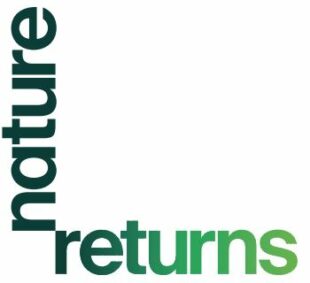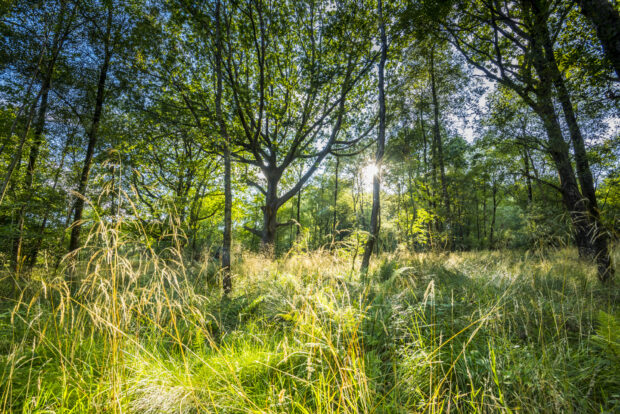 Emma Stewart, our Carbon Markets Project Manager, explains more about the Nature Returns Programme - a partnership exploring approaches to creating and restoring natural habitats in ways that tackle climate change and biodiversity loss.
Emma Stewart, our Carbon Markets Project Manager, explains more about the Nature Returns Programme - a partnership exploring approaches to creating and restoring natural habitats in ways that tackle climate change and biodiversity loss.
There is lots of evidence about how trees and woodland sequester carbon from the atmosphere. But what about carbon sequestration in other types of habitat? What about scrub, heathland, or hedgerows?
Although we know that different types of habitat also sequester carbon, at present there is limited data available to enable us to understand exactly how much. With woodland currently covering only 10% of land in England (albeit increasing), there is much to learn about the role that other types of habitat can play in tackling the climate crisis.

Nature Returns Programme
Since April 2021, the Nature Returns Programme (funded by HM Treasury via its Shared Outcomes Fund) has been working to bridge this knowledge gap. The Programme, led by Natural England, in partnership with the Forestry Commission, Environment Agency, and Royal Botanical Gardens Kew, and sponsored by Defra and DESNZ, has been exploring approaches to creating and restoring natural habitats in ways that tackle the twin challenges of climate change and biodiversity loss. Understanding how the landscape works holistically is key to understanding how and where carbon is stored.
The Forestry Commission is lending its expertise to the Programme through its experience with the Woodland Carbon Code (WCC). Since 2011, the WCC has supported the development of a highly credible market for the sale of carbon from tree planting, thanks to the robust scientific research that backs it up – helping to boost rates of woodland creation in the UK by making it more financially attractive. By joining forces through Nature Returns, our organisations are working together to better understand how private finance can be brought in to create and restore other types of natural habitat outside of woodlands.
On the ground, Nature Returns is working with local partnerships in six established project areas which are creating and restoring different types of habitat that can contribute learning to the Programme, recognising that collaboration is key to the success of landscape scale nature projects. These project sites, spanning the length of England from Plymouth to Northumberland, were selected for their ability to work in ways that deliver nature-based solutions to climate change and biodiversity loss. Already established, and each with unique objectives and design, these projects are pioneering in their work to deliver holistic environmental outcomes that deliver multiple benefits. The projects’ different approaches to solving local problems – but on a landscape scale – are providing valuable insights that the Programme will seek to build on. The Forestry Commission’s Nature Recovery Advisors are supporting the projects with their woody habitats, and creating a link to Local Nature Recovery Strategies.
Building a Bank of Evidence
The project sites are providing the Programme’s scientists with valuable study areas to gather data. Access has been granted to Natural England to allow them to measure the carbon flux of different habitats (as well as measuring biodiversity), whilst RBG Kew is carrying out similar work at its Wakehurst site to address key questions on the trade-offs and interactions between ecosystem function and carbon sequestration.
Meanwhile, the Programme is also working with the projects behind the scenes to explore how their partnerships can work effectively together to deliver their ambitions. The Environment Agency is investigating the role of good governance, and how private finance can be brought in to secure long-term ‘nature returns.’ They have worked with research partners to better understand the different models for the aggregation of buyers and sellers of ecosystem services, as well as engaging with investors for their views on nature markets. Bringing in these stakeholders is providing us with valuable information that will help fund future habitat creation through private finance.
Fuelling the Carbon Market
As more and more organisations declare net zero targets and strategies, the demand for carbon units in the voluntary carbon market (such as those certified by the WCC) far outstrips the supply. The Natural Environment Investment Readiness Fund (NEIRF) has been supporting the development of new Codes and Standards like the WCC, and Nature Returns is creating opportunities to test these in our local partnership sites.
For buyers, it is an exciting prospect that new Carbon Standards are in development: there will be more carbon units for sale on the market.
But navigating the voluntary carbon market has its challenges. The prices paid for carbon units backed by the WCC are not disclosed to the market, and remain a private transaction between the buyer and seller. As the voluntary carbon market grows, and new Carbon Standards are published, a buoyant market will need greater transparency in the prices that carbon units are fetching. Through Nature Returns, the first steps towards this have been taken by reporting on the prices paid for carbon units backed by the WCC and Peatland Code (PC). This engagement was carried out by Ecosystem Marketplace, and the results of their work can be found here. This research will contribute to developing our understanding of blended funding models, which are key to unlocking future opportunities for getting nature projects off the ground.
Nature already has many of the answers to climate change and biodiversity loss. Through working in partnership, Nature Returns is taking a holistic approach to seeking out these answers, providing the evidence to enable investment in nature recovery, and allowing us to reap the rewards.
 To find out more or access reports being produced by the Programme, visit the Natural England Nature Returns evidence page.
To find out more or access reports being produced by the Programme, visit the Natural England Nature Returns evidence page.




3 comments
Comment by John Makepeace posted on
Is there a risk that Carbon Credits, often in the form of buying forests, will be gobbled up by industrialists to allow them to continue current levels of pollution? It seems that is already happening.
If trees are being planted for carbon capture, then the incentive to manage our woodland better is being undermined. As we have learned, narrow objectives work against sound ESG practice.
Comment by wendyjohnson posted on
Emma says: Thank you for your comment. The Forestry Commission is committed to enabling good woodland management and supporting organisations to decarbonise, using carbon units as a way to offset any residual emissions that can't be avoided.
Voluntary carbon markets across the world are under intense scrutiny. A series of initiatives - globally and in the UK - are aiming to bolster confidence in projects supplying carbon credits and in buyers that wish to purchase and use them against their carbon footprints. The Scottish and Westminster governments are involved in work to provide frameworks to underpin best practice in carbon and other environmental markets across the UK.
Recent criticisms of carbon schemes in the Amazon concerned projects where too many credits were issued. Standards such as the Woodland Carbon Code use a conservative approach to calculating GHG emissions removals, by applying significant downward adjustments to the estimates. The UK carbon market also operates in an institutional and policy environment that provides particular safeguards over permanence and the delivery of wider social and environmental benefits.
Offsetting is a legitimate part of an organisation’s plan to reach Net Zero if done appropriately. It is vital that carbon credits used in offsetting schemes are of high quality and that purchasers of offsets demonstrate a credible plan to reduce emissions as much as possible. Initiatives such as the Voluntary Carbon Markets Initiative Claims Code of Practice exist to encourage organisations to use claims about offsetting effectively and transparently. Standards such as the Woodland Carbon Code (WCC) and the Peatland Code (PC) apply ‘core carbon principles’ to underpin integrity in the carbon market. These include showing that carbon credits represent a permanent and ‘additional’ benefit to the climate, that all emissions reductions and removals are independently monitored and verified, and that they are reported accurately and transparently. ‘Additional’ means that any offsetting activity such as woodland planting would not have happened in the absence of the carbon market. The additionality rules applied by the WCC are critical to generating market confidence. The additionality tests have been strengthened in 2022 to ensure that all claims of offsetting are genuine, and to reassure buyers and investors. It is essential that buyers of carbon credits demonstrate integrity in the market, in particular by showing that they have a credible plan to reduce greenhouse gas emissions, using carbon credits to offset emissions that are either difficult or impossible to reduce. A recent <a href="https://www.ecosystemmarketplace.com/publications/2023-em-all-in-on-climate-report/">study</a> demonstrated that voluntary carbon buyers are reducing greenhouse gas emissions more quickly than their peers, and are spending more on these reductions.
Through its various initiatives, the Forestry Commission supports good woodland management. All WCC projects must be managed in a way that is compliant with the UK Forestry Standard. WCC projects must also use the Woodland Benefits Tool to describe the social, environmental and economic benefits that their woodland will have. WCC projects are validated upon application to check the amount of carbon they are expected to sequester, and verified at least every 10 years to check that the predictions were correct. The validation/ verification body will be checking that there is no evidence of non-compliance with the UKFS. Since projects are verified at least every 10 years, woodland management will be checked regularly, and there is an incentive for landowners to ensure the woodland is properly managed so that trees grow as expected, and thereby sequester carbon as expected. Carbon sequestration, whilst important, is only one of the positive outcomes of good woodland management, and carbon yield varies by management regime - this is all incorporated into the Woodland Carbon Code.
Comment by iainplumer posted on
We are the river project,we are dyslexic ,with super powers to sort this mess in the rivers ,we make charcoal filter rivers charge the charcoal and then give to the land to feed the mycro organism that feed us.we are doing this with no funding but could do with a champion if you can help please make contact